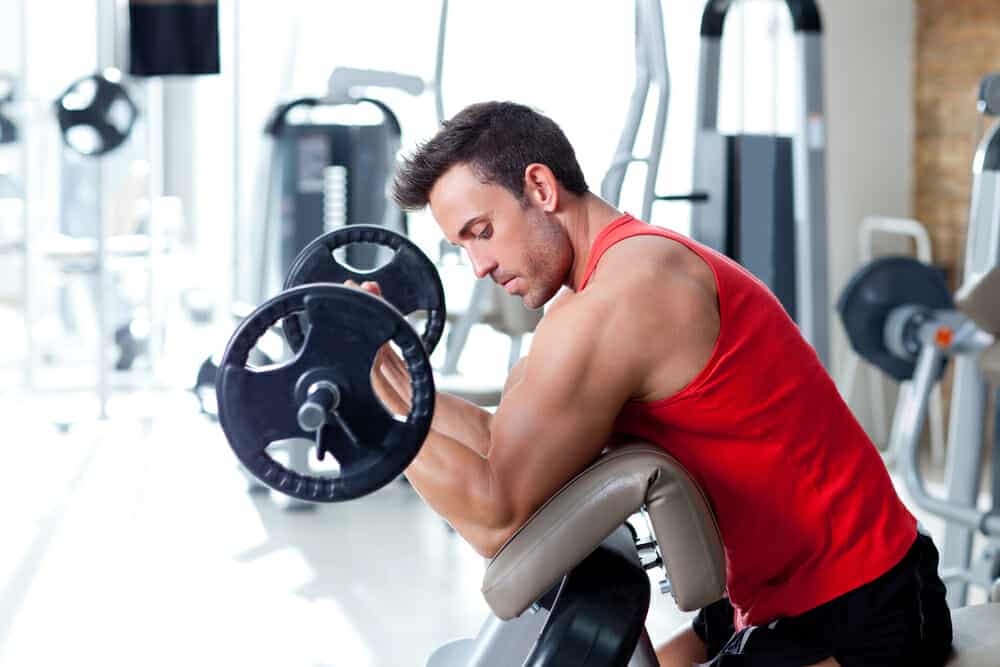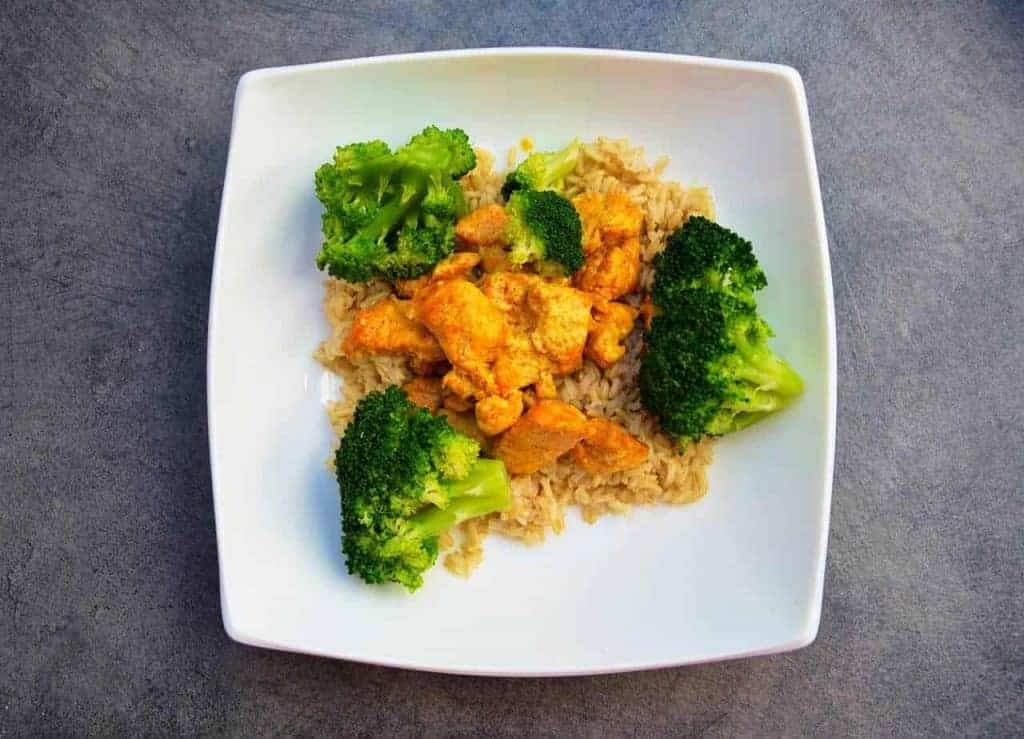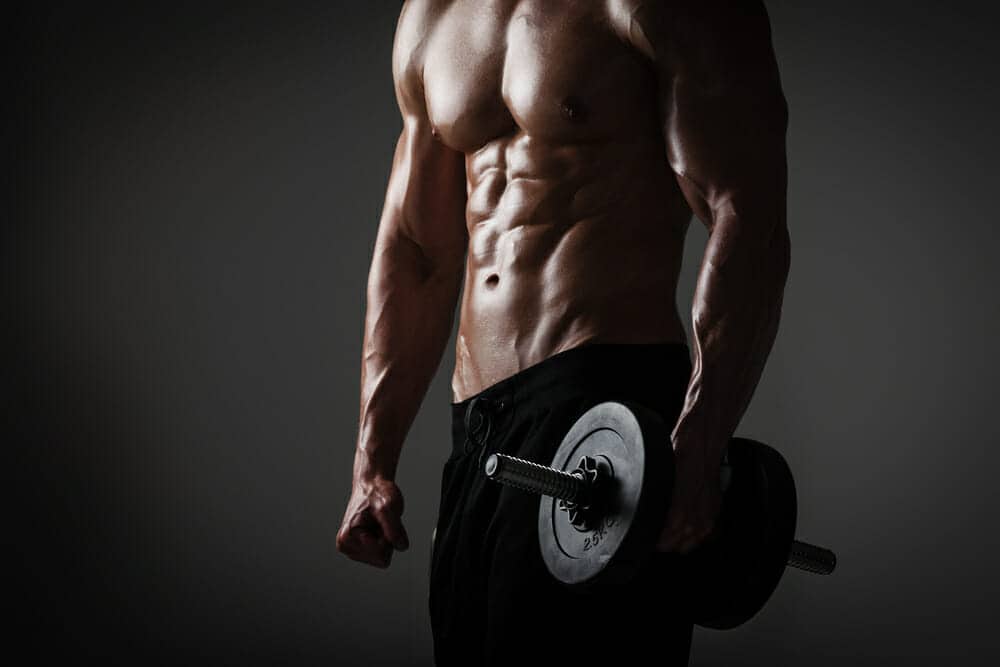How to gain mass? Everyone would like to see quick and visible results of hours spent with a barbell in hand and litres of sweat poured out at the gym. The problem is that the rate of gaining muscle mass is often very slow. Lack of expected results demotivates many a gym-goer and leads to the abandonment of efforts to build muscles. Meanwhile, it’s not worth giving up on your figure goals due to lack of results. You only need to make a few modifications in nutrition, supplementation and activity programme, thanks to which you will stimulate your muscles to more intensive work, provide them with more building material and intensify anabolic processes. Read the article and learn proven methods for rapid muscle mass building.
Table of contents
Muscle structure and the way it functions, or what affects muscle mass gain?
Muscle structure, types and role in the body
Muscles are elements of the musculoskeletal system connected with bones by tendons. The main task of muscles is to move the skeletal system and change the position of the body. In other words, thanks to muscles we have the ability to move.
In addition to their motor functions, muscles play several other roles, among others: they take care of maintaining the correct posture of the body, they provide movement to the internal organs and enable them to work properly, they are responsible for the flow of fluids in the body.
In our body there are about 500 muscles. They are literally everywhere, even in the eye. In terms of structure, muscles are divided into 3 types: smooth muscle, skeletal muscle (striated) and cardiac muscle (striated muscle of the heart). Each of these types of muscles has a different structure.
Biceps, triceps, chest muscles, thigh muscles and all other muscles that we shape and stimulate to growth in the process of body shaping belong to the group of skeletal muscles, i.e. striated muscles. These muscles are built from a network of adjacent to each other, located parallel thin fibers called myofibrils. They are grouped into so-called bundles. Myofibrils are composed of cells called myocytes. They have the ability to contract and contract. The muscle fibers are covered by a soft tissue called fascia.
How do muscles grow?

How do our muscles build up? Many factors influence the rate and intensity of their growth, including diet, hormone balance and genetics. However, the most important factor for the development of our muscles is physical activity. What matters here is both the type of training (muscles grow the fastest when exercising with weights, the slowest when aerobic), as well as the time of individual training sessions, the number of repetitions and series of individual exercises, the weight of weights used during exercise, the frequency of training.
In addition to training, the second factor determining the efficient growth of muscle mass is post-workout regeneration. It is during recovery that the process of tissue renewal begins in our body, including the renewal and growth of muscle tissue.
How do muscles grow? During a heavy effort (e.g. during a workout in which we lift weights) muscles do a lot of work. This causes micro-damage to the muscle fibres. The repair processes of the damaged tissue are then activated, and new muscle fibres appear in the place of each micro-damage.
Through the systematic building up of fibres, the muscle becomes bigger and bigger. The building material for new muscle tissue is protein, which is why the role of this nutrient in a bodybuilder’s diet is so important.
There’s a reason why there’s so much talk about the fact that during a training cycle for muscle mass both factors – training and regeneration – are equally important. Each subsequent training session contributes to the formation of muscle micro-damage necessary to initiate the recovery process. And the period between one workout and the next, the regeneration period, is the time when this rebuilding (and superbuilding) takes place.
How to gain mass? Important training tips
- Regular strength training stimulates anabolic processes, which results in the systematic growth of muscle cells and, consequently, increases muscle mass. In principle, without training, there is no question of muscle growth. However, many bodybuilding enthusiasts make a lot of training mistakes, which result in a lack of effects or a slow rate of muscle growth. How to optimise muscle mass training to achieve the best results?
- Do not exercise too often or too rarely. For beginners it is recommended to visit the gym 2-3 times a week, after some time it is worth increasing the frequency to 4-5 times. The duration of strength training is also important. Optimal duration is 45 minutes (not including warm-up and stretching).
- We should apply the rule of gradually increasing the load and the number of series and repetitions. In this way our muscles will be constantly mobilized for hard work and constant overbuilding. At the same time we will protect ourselves from possible injuries and overtraining.
- We should watch the technique of performing exercises. Maintain appropriate breaks between series of exercises (1-2 minutes). While performing a given exercise, try to make the second phase, that is, lowering the weight, longer (e.g. during barbell pressing, we lower it very slowly).
- Make sure that our training plan is varied. We should not allow our body to get too used to a given pattern of activity, because it may result in a lower rate of mass gain. Therefore, we should avoid excessive training monotony. Modify the sets of exercises performed, introduce new ones from time to time, change their order, number and variants.
- Do not skip any muscle parts during training (e.g. legs). Let us perform exercises both for the chest, biceps, shoulders, and for the abdomen, back, thighs or calves. Musculature should be developed evenly.
- Remember to consume carbohydrates just before training, as well as immediately after. A portion of simple carbohydrates before entering the gym and immediately after exercise will allow us to replenish muscle glycogen and prevent catabolism (a state in which muscle tissue decays as a result of insufficient supply of energy).
- Training plan for mass must be adapted to our capabilities and current physical form. Do not train too intensively, do not overexert yourself. Do not train beyond your limits and do not suddenly start working out with huge loads, but increase them gradually. Training too hard in relation to the real capacity of your body can have negative effects. It may contribute to the body entering a state of catabolism, in which exhausted muscles “eat” themselves. It can also result in muscle strain and injuries.
- Let’s choose the type of training appropriate for our level of experience. For beginners and intermediate trainees we recommend FBW (Full Body Workout), during which we perform multi-joint exercises on all muscle groups. For people with longer training experience we recommend Split workouts, where you exercise a different muscle part during each training session.
- We should pay great attention not only to trainings, but also to sleep. The appropriate length and quality of sleep is a prerequisite for effective regeneration, and thus for good results in building and shaping muscles. Let’s try not to overwork, let’s take care of our mental condition. Chronic exhaustion, lack of sleep and chronic stress are the enemies of high physical performance and efficient muscle building.
Check it out: Ranking of Testosterone Boosters

How to gain mass – positive calorie balance diet
Building muscle is a process in which nutrition is of great importance. A mass gaining diet may not be particularly difficult or demanding, but it must be well thought out and adapted to the number of calories and the presence of nutrients important for muscle development.
Anabolic processes are stimulated not only by training, but also by a well-balanced diet. If we want our muscles to grow dynamically, we need to provide them with large amounts of energy and building material. That is why the training diet for mass should contain a caloric surplus. It is recommended to consume 20% more calories per day (about 500 kcal) than our caloric needs.
On the other hand we must be careful what we build this surplus on. Being in a mass gaining cycle it is easy not only to gain muscle but also additional fat tissue, as many gym-goers have found out. Where is the trap? We often miscalculate the amount of calories we consume. We think that we are eating properly, but in reality the calorie surplus is far too high, which results in the storage of fat reserves.
Fast food, sweets, ready meals, coloured drinks, salty snacks, processed foods in general, contain a whole lot of excess calories, of which we are often not even aware. Excess cal ories in the diet for mass should not be too large and should come mainly from protein products. If we do not want to gain extra folds of fat, we need to watch out for foods rich in simple sugars, trans fats and saturated fats.
- The menu should be based on products with a high content of protein (dairy products, eggs, fish, lean meat, legumes, quinoa, groats, chia seeds, amaranth, grains and seeds).
- Each day you should eat about 1.8 g – 2 g of protein for each kilogram of body weight (for example, if you weigh 80 kg, daily protein intake is about 160 g).
- Do not skip meals, eat 5-6 times a day, do not take longer than 3 hours between meals. Try to include at least one high-protein product in each (or almost each) meal.
- Themeal before the workout and the meal after the workout should contain simple carbohydrates. In all other meals try to use sources of complex carbohydrates (e.g. wholemeal bread, groats, brown pasta and rice, oatmeal, vegetables).
- Provide variety in your meals, don’t eat the same thing all the time. Use different sources of protein and carbohydrates, create various culinary combinations. Leave plenty of room in your meals for vegetables and fruit. And let’s not forget about healthy fats (vegetable oils, fatty fish, nuts, avocados, seeds), which should also feature in our menu.
Read also: What to eat for mass?
Supplementation during weight gain
Training and diet for mass allow you to gradually increase the volume of muscle. On the other hand, mass gaining mass supplements boost anabolism, accelerate and intensify muscle growth, but also provide other benefits: they add strength and energy, improve training efficiency, comprehensively support our bodies during increased exercise cycles and improve regeneration.
Which preparations should we use while building muscles?
Most gym-goers’ sets include protein for mass, creatine, amino acids and gainers. Lately supplements containing amino acids, creatine, protein, and ingredients giving muscle pumps and providing energy (e.g. NutriGo Lab Mass) are also becoming more and more popular.
Such a supplement with a wide composition allows you to increase muscle mass at a rapid pace, while maximising your physical performance. What’s more, by purchasing one supplement with a wide composition, you avoid buying and using several different preparations – it’s more convenient and cheaper.
Check it out: Ranking of Supplements for Mass
Meals for mass gain

Preparing meals that are rich, tasty and at the same time actively support muscle building is quite a challenge. Gym-goers often find it difficult to compose protein menus and prepare protein dishes, especially those who have had little contact with cooking before.
Meals for mass gain are a bit more demanding than regular breakfast sandwiches, because they force us to take into account the appropriate amounts of individual nutrients, mainly proteins and carbohydrates. On the other hand, meals for weight gain are not particularly difficult or time consuming. It is also very quick to become proficient in their preparation.
Meals for mass – protein is a priority!
Being in the cycle for mass, the most place on our plate should be occupied by protein. The best sources of it are meats with low fat content (e.g. chicken or turkey breast, skinless duck breast, lean beef, pork tenderloin), fish (e.g. hake, walleye, cod, salmon, tuna, mirin) and pluck (e.g. liver, heart).
You should also reach for eggs, seafood and legumes, which are an excellent source of vegetable protein. Rice, groats, yoghurt, kefir, cream, cereals and bran are also high in protein.
What we should remember is that meals on a diet for mass should be varied and provide the body not only with protein, but also a number of other important nutrients. It is worth taking care of the appropriate amount of products rich in vitamins and minerals and complex carbohydrates (salads, greens, cooked vegetables, groats, rice, pasta).
Cheap and simple meals for mass – recipes for 3 dinners
Braised chicken livers with vegetables
Liver contains a lot of protein and iron and is great for a weight loss diet. If you season it well and combine it with interesting additives, you will obtain a dish with very interesting taste qualities. For example, it is worth preparing liver in the company of green beans and broccoli. They go well with liver, and most importantly – they contain a large amount of vegetable protein, which, as we know, is a great ally of a diet for muscle mass. To sharpen the taste, it is worth adding some stewed onions and a few spices. The dish can be served with pearl barley or buckwheat groats and salad.
Ingredients:
- 0.5 kg poultry liver
- approx. 200 g green string beans
- approx. 200 g broccoli
- 2 onions
- spices: salt, pepper, hot pepper, garlic, marjoram, thyme, parsley
Preparation:
Wash and dry the liver. Shred the broccoli and cook the beans. Slice the onion and fry in the oil until golden brown, remove from the pan. Coat the liver in flour, fry in oil. Add previously fried onions, beans and broccoli cut into smaller pieces. Pour a small amount of water into the pan, season the dish with pepper, paprika, marjoram, dried garlic, thyme and parsley. Do not spare the spices. Stir everything, simmer covered for a few minutes over low heat. Add salt at the very end of cooking.
Tuna and vegetable casserole
Fish are an excellent source of easily assimilable protein, rich in all essential amino acids, so if you are on a diet to gain weight, try to reach for them as often as possible. Tuna in own sauce from a tin is perfect for quick and simple dishes, for example casseroles. We take tuna, some pasta, a few vegetables, some cheese, herbs and spices. This comes out as a distinct, aromatic, very tasty dish.
Ingredients:
- 2 cans of tuna in own sauce
- 1 jar of mixed canned vegetables (carrots, peas, corn or carrots and peas)
- 1 tin of sliced tomatoes in brine
- 1 jar green olives
- 1 red pepper
- 2 onions
- approx. 250 g yellow cheese
- approx. 200 g pasta
- Spices: basil, oregano, marjoram, thyme, granulated garlic, chili, salt.
Preparation:
Cut the onion in half slices, the pepper in strips. Lightly fry the onion in a little oil, after 2-3 minutes add the peppers. Fry for a few minutes. Boil pasta and cool it down. Cut the olives in half. Mix the pasta with all the vegetables, add a big pinch of all the spices, finally add the drained tuna and gently mix the ingredients once again. Put part of the mixture into the ovenproof dish, sprinkle it with half of the grated cheese, put the other part of the mixture, sprinkle with the remaining cheese. Bake the dish for about 30 minutes at 180 degrees.
One-pot dish with leguminous vegetables in the main role
Legumes are rich in protein, so you should often use them in a diet for weight. They are suitable not only for dinner dishes, but also for stuffings, salads, salads, salads, homemade spreads, soups. Here is a simple and quick recipe for a real bomb of vegetable protein, that is, a one-pot dish with legumes.
Ingredients:
- 1 can of chickpeas
- 1 tin of red beans
- 1 tin of green peas
- 1 can of green beans
- 200 g tomato paste or tomato paste concentrate
- 2 onions
- 2 peppers
- 200 g mushrooms
- optional: chicken breast fillet
- seasonings: salt, sweet and hot paprika, pepper, nutmeg, curry, herbs de Provence
Preparation:
Slice the onion into feathers, the pepper into strips. Fry them until soft. Peel and chop the mushrooms and fry them as well. If you want to add chicken to the dish, dice it and fry. In a large pot put chickpeas, beans, peas, green beans, pour about 1,5 glass of water, add tomato paste or concentrate. Mix. The consistency of the dish should be slightly watery, but thicker than a classic soup. Add previously fried vegetables and optionally chicken. Cook everything over low heat for about 15 minutes. Add spices, cook the dish for another 10 minutes.
Check: Ranking of pre-training products

